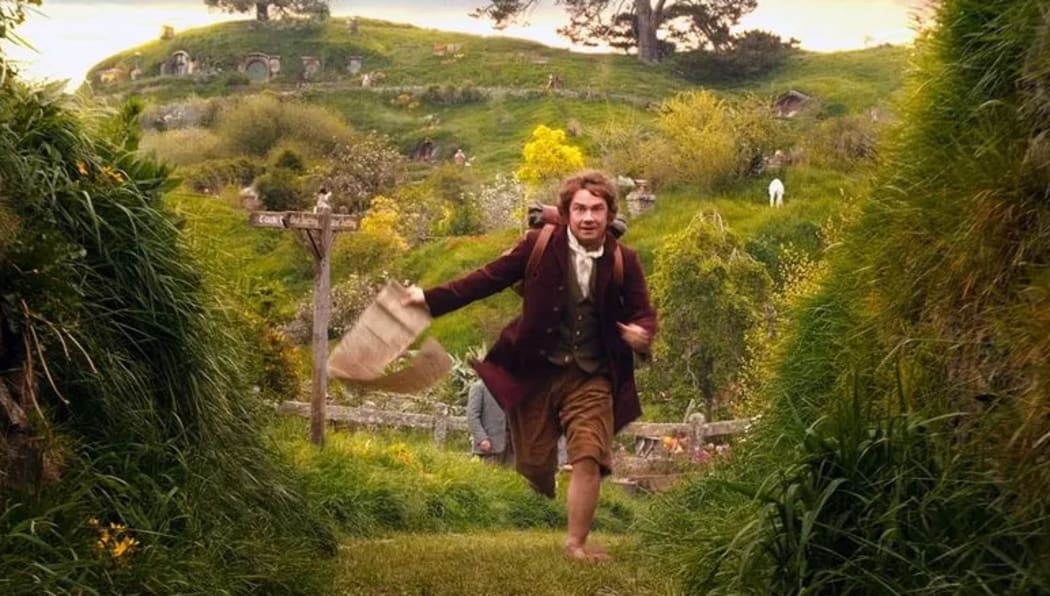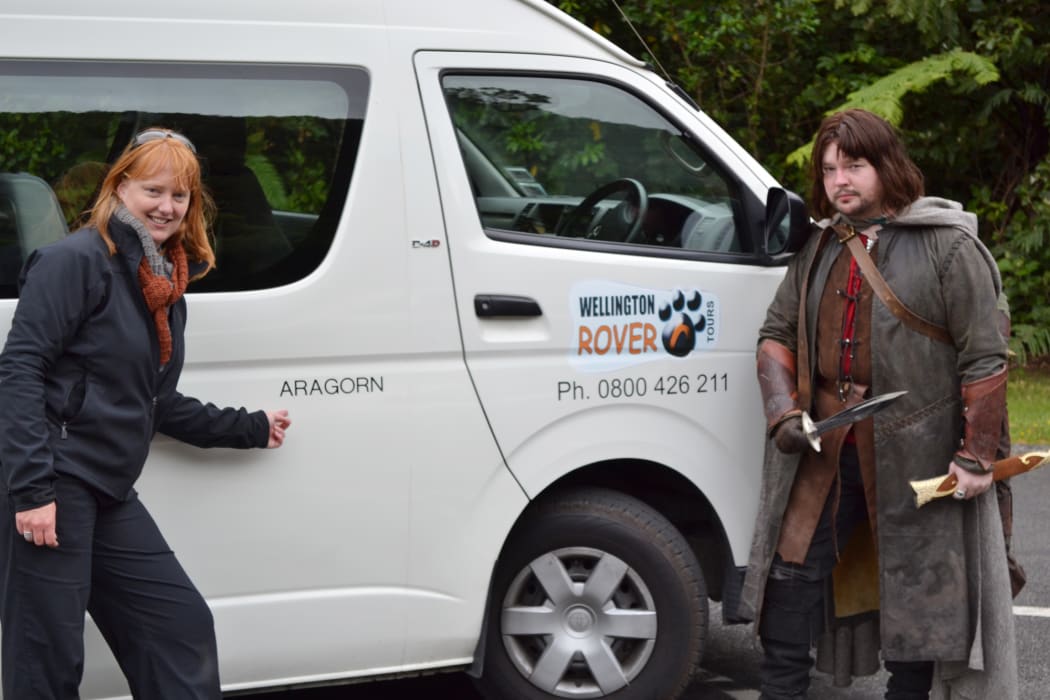For more than a decade New Zealand has drawn Middle Earth fanatics who are so Tol-keen on the stories that they learn fantasy languages, steal from their parents and even suffer through a fractured neck all for a glimpse of a hobbit. But with the last of The Hobbit films completed, will New Zealand be able to keep the travellers coming?

Bilbo Baggins leaving Hobbiton on his quest. There are now guided tours of the set near Matamata. Photo: Warner Bros
When Leander Schulz was 16 years old he could barely point out New Zealand on a map, but he knew it was where Lord of the Rings was made.
As a high school student in Germany, he made up reasons for his parents to send him to Middle Earth on an exchange. “I just said, England is so close and I may even chicken out and come back and it should be a challenge for myself so the distance is good for me. But also that I’d read and heard really good things about New Zealand but I actually didn’t at that point, I had no idea.”
Leander’s exchange was only half-a-year but it was long enough for him to fall in love with the country, although it took him nearly four years to get back.
When I was really into Lord of the Rings, I did crazy stuff, like I’d steal my Mum’s personal ID in order to do an illegal purchase of this beautiful sword replica ...
“It’s very far away, it’s very expensive to get here and you’re essentially cut off from everything that you would have built up on the other side of the world. Deciding to study here, which happened later, essentially meant that I cut myself off from my family for a very long time.”
Leander, now 26, was consumed by the world JRR Tolkien created, and Sir Peter Jackson brought to life. “When I was really into Lord of the Rings, I did crazy stuff, like I’d steal my Mum’s personal ID in order to do an illegal purchase of this beautiful sword replica and I was completely immersed in that story and that world.”
But The Hobbit films haven’t enthralled him in the same way, possibly because he’s a little older, he says.“Watching The Hobbit it felt almost unreal to me, more like a computer game, way too bright and colourful. It didn’t have that mystique and darkness of the Lord of the Rings movies.”
***
The journey to the “real” Middle Earth for many fans is a type of pilgrimage comparable to that taken by the film’s characters, and sometime retracing their steps - like standing on the patch of dirt where Frodo and his small hairy friends jumped off the road in The Fellowship of the Ring.
Tourism New Zealand’s 100% Middle Earth marketing campaign aims to turn this romantic idea of adventure into cash for the tourism industry. It’s video clocks in at just under 2.1 million views on YouTube and in true Middle Earth fashion, there’s an extended version too. Several of the YouTube viewers were swayed enough by the line “traveller, your dreams are waiting” to proclaim their commitment to visit New Zealand in the comments section.
There has certainly been a boom in tourism since movie-goers first saw Frodo’s epic quest on the big screen. Tourist arrivals to New Zealand increased by 52 percent from 1.78 million in 2000 to 2.71 million last year.
Thirteen per cent of holiday arrivals who took part in the Oct-Dec 2013 International Visitor Survey say they were enticed to New Zealand by The Hobbit trilogy. More than twice that amount that said they were here because of Lord of the Rings in 2004.
Despite a slight levelling in visitor numbers between the two trilogies, Tourism New Zealand boss Kevin Bowler is optimistic they’ll keep coming.
“I think what we had between the Lord of the Rings and the The Hobbit was the Global Financial Crisis, and that sort of overwhelmed everything, we had quite a flat period through the mid 2000s and into about 2011, 2012 and it’s only really in the last two or three years, since the first hobbit film came out, but also since the financial crisis started to ease a little bit, that we’ve seen growth come back into international visitors.”
He says Lord of the Rings was still resonating ten years after the films were released. “With things like Hobbiton there’s every reason to expect that we’ve got another ten years in front of us and hopefully we can go quite a lot longer than ten years.”
The guides, a lot of their touring is Lord of the Rings, so we require that level of passion about that movies. We all go to the movies and rewatch them.
Also hoping the tourist boom will last for years to come is the operations manager for Rover Tours Wellington, Nathan Clear. For ten years he’s guided visitors to the “Get off the Road” location, Weta Studios, and the elvish outpost Rivendell.
After so many years, Nathan says the tourism benefits the films bring to Wellington are what help him out of bed every day.
“A lot of my passion for Lord of the Rings has come from what it’s done for us as a company and what it’s done for the city. It’s easy to get passionate when you see the effect that it’s had,” he says.
“We’re obligated to love the Lord of the Rings. The guides, a lot of their touring is Lord of the Rings, so we require that level of passion about that movies. We all go to the movies and rewatch them.”
But Nathan says the fans are also a source of inspiration.
“These people have travelled, a lot of them, a huge increase in our visitors from Europe and North America and that’s directly related to the films. There’s no easy way to come to New Zealand. They have decided to fly all the way around the world to look at this stuff and you can’t help but absorb some of their passion.”
The excitement for the story that encourages people to journey to New Zealand is not unexpected so soon after the release of the latest Hobbit film. But how does Nathan feel about the sustainability of Middle Earth film tourism in the long run?
“Lots of people use the example of The Sound of Music and it’s one I’ve always used. People are still there, they’re still busy, there’s nothing to see there either but they still turn up,” he says. “I must admit sitting at the world premiere, here in Wellington at the Roxy (cinema), and watching the live feed to [the] London [premiere], we were counting all the little people in the crowd, the young teenagers, who, when you hear them interviewed, are still really keen to come to New Zealand, this is ongoing business for a long time.”

A tourist on the hobbit trail dressed as Aragorn, from The Lord of the Rings. Photo: Rover Tours
Part of ensuring the longevity of this business is making Wellywood as synonymous with film in the bottom half of the globe as Hollywood is in the Northern Hemisphere.
Positively Wellington Tourism chief executive David Perks believes the trilogies have played a huge part in pushing the city towards that position.
“We can think of numerous films which have garnered cult status. Star Wars would be a good example, where the story behind the film, the passion for them just keeps returning. I think this is the same and I think that so much of what people are looking for now as tourists, is experiences,” he says. “It’s not just go see and go away again, people want to have experiences and I think Hobbiton in the Waikato, Weta workshops, both provide an intimacy to the experience where you learn all about how the film was made, the people who made the film and you actually put yourself into the place where those people have been.”
Whether or not we’ll have maps to the stars’ homes in Wellington though will depend on how committed the Government and the tourism industry are to prolonging the 100% Middle Earth image.
Alfio Leotta is a film studies lecturer at the Victoria University whose PhD focused on film and tourism in New Zealand. He wouldn’t pull out his palantir (crystal ball) to predict the country’s film tourism future but says the effect of a film on tourism has been compared to the effect of a hallmark event, like The Olympics, that raise interest in a destination.
He says the survival of Middle Earth tourism beyond the films now rests on the extent to which tourism stakeholders will be willing to invest.
“One of the reasons Middle Earth/New Zealand as a tourism destination was so popular was because of the investment of Tourism New Zealand, Air New Zealand, and the New Zealand government in terms of resources, money, marketing campaigns and so on,” he says.
... the next major blockbuster that will be made in New Zealand is the Avatar sequels, so it will be interesting to see if Tourism New Zealand will do something to promote New Zealand as Pandora which is the imaginary world where Avatar is set.
Tourism New Zealand has spent about $30 million over three years marketing the country through The Hobbit films. The return on this investment is difficult to pinpoint, however in the 2004 International Visitor Survey one per cent of visitors who said that the Lord of the Rings was their main or only reason for visiting spent an amount relating to approximately $32.8 million.
Alfio says Tourism New Zealand will have to consider if continued investment in this notion of New Zealand as Middle Earth will still be profitable ten years from now but film tourism in general does not have to end.
“I think in the early 2000s New Zealand has been able and willing to embrace this new identity as Middle Earth. Maybe in the future it will be willing to embrace something else, and obviously the next major blockbuster that will be made in New Zealand is the Avatar sequels, so it will be interesting to see if Tourism New Zealand will do something to promote New Zealand as Pandora which is the imaginary world where Avatar is set.”
But he admits the fantasy world Pandora would be a more difficult association to sell.
“[That’s] much harder to do and to be honest I don’t think that will be as appealing as Middle Earth but at this stage I think it’s hard to predict what will happen in the future.”


